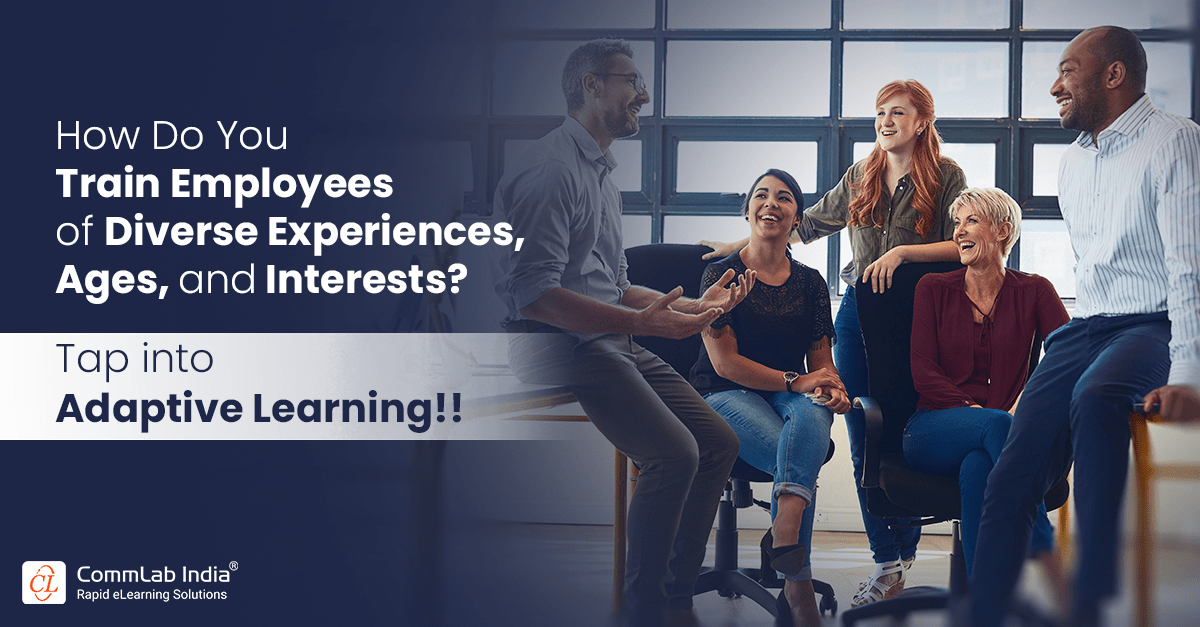5 Ways Adaptive Learning Leads to Better and Faster Employee Performance

Even in the age of digital technologies, most of us still consider one-on-one instruction highly effective in corporate training. The primary reason being trainers can individualize instructions in real-time. And that’s where conventional eLearning falls short. Although eLearning is enough to meet most of your training needs, sometimes your learners could do with some guidance or additional explanation. This especially holds good when you need to guide learners towards content mastery. So what can you do to offer online training that seems like one-on-one training? This is where adaptive learning in online training can help you fill the gap.
How does adaptive learning lead to better and faster employee performance?
- Offers relevant learning
- Reduces training time
- Offers a variety of learning experiences
- Provides adaptive assessments and real-time feedback
- Is easier to scale up personalized learning
What Exactly is Adaptive Learning?
Adaptive Learning in online training uses inference algorithms to tailor and sequence eLearning courses based on learners’ response to activities and questions. And the best part, it’s in-the-moment and contextual. Within an eLearning course, the adaptive algorithm takes personalization a step further by:
- Tracking data such as learning points taken and questions answered in a course
- Assessing the collected information against pre-programmed criteria for the training
- Automatically adapting the learning path that will come next including the content, difficulty level, delivery method
So to say, adaptive learning continually adapts training to make it more learner-centric by offering learners their own personalized path to mastery. Without further ado, let’s check out the 5 ways adaptive learning results in faster and better employee performance.
Adaptive Learning: 5 Ways How it Can Help Enhance Employee Performance
1. Offers Relevant Learning Only
Depending on your audience, learners may already be familiar with some portions of your eLearning content. This may result in disengagement since learners fail to derive much relevance out of what is already known. Perhaps they might even skip portions of the content and miss out on relevant information ensconced in between; something that isn’t very beneficial.
Online training using an adaptive learning approach could adjust to their current level of knowledge.
This implies that the adaptive engine only offers eLearning resources that fill the prevalent knowledge gap, ensuring a relevant and value-added learning experience. Moreover, learning can be offered in small chunks, allowing learners to master one thing at a time. So, to put it simply, adaptive learning focuses on skills and knowledge that your employees do NOT possess currently or are less confident about.
For instance, you can offer a pre-assessment before starting an online training. This helps the LMS evaluate the level of existing knowledge. Depending on the results, learners can be guided to the relevant eLearning modules they need further training on. So, if learner A and learner B take a pre-assessment, upon completion learner A might be assigned modules 1, 2, and 3 while learner B might get 3, 4 and 6 to complete. Moreover, learners will be intrinsically motivated to learn when they know it will help them fill their individual knowledge gaps and enhance competency.
2. Reduces Training Time
In adaptive learning, learners spend time only on areas which require development and skip what they have mastered already. This drastically reduces the training time required to reach proficiency. According to a report by ATD, as much as 50% of time savings are common among the early adopters of adaptive learning as compared to conventional eLearning or instructor-led training. Quite evidently, an adaptive learning approach can cut the time a learner requires to attain mastery by half, compared to other approaches.
This is all because there is no need to re-teach what your learners already know, instead focusing on where they need to become competent. Greater efficiency implies more time for learners to be on the job than in training.
3. Offers Different Learning Experiences
Adaptive Learning approach can offer better learning experiences because it can adjust to your learners’ unique needs. More specifically, the adaptive system records learning preferences and offers different kinds of learning resources – based on the same objective – on the fly! The resources can be in the form of videos, game-based activities, story-based scenarios, which can accelerate the time to proficiency.
For instance, a learner struggles with part of an eLearning module that used labeled graphics to showcase features of a product. Here, the adaptive learning engine might serve up a video which caters more to the preference of the learner. An expert can explain the different features while identifying components of the product in the video. Same object; different experience. This time around, the learner achieves the objective in no time. In this case, the video led to a better learning outcome. And that’s when a little creative redundancy and adaptive learning saved the day!
What if even the instructional video failed? The adaptive system would guide them to another experience. This level of personalization makes learning more engaging when learners are constantly challenged to learn skills that are relevant to their job.
4. Provides Adaptive Assessments and Real-Time Feedback
Apart from customizing training content, you can even make your eLearning assessments adaptive! Adaptive assessments change the questions learners attempt based on their response to previous questions.
For instance, subsequent questions turn hard if learners answer accurately. Similarly, they turn easy if learners are struggling in the assessments. Hence, adaptive assessments maintain the difficulty level by keeping in mind the learners’ performance. This is unlike conventional eLearning assessments where the subsequent question is not impacted by the response of the previous question. Learners are assessed on fixed questions irrespective of their performance. This method is often used to benchmark learner understanding or progress.
The adaptive learning approach also offers learners regular opportunities for self-assessment. This happens by asking learners to rate themselves on their content knowledge before they view the correct answer or perform a task. This way, learners not only improve their knowledge, they also gain confidence in applying that knowledge, allowing them to move toward on-the job application faster. Real-time diagnostic feedback also plays an imperative role in helping learners confirm their knowledge before moving ahead.
5. Is Easier to Scale Up Personalized Learning
A perfect training strategy would be to offer every employee with a guide or a mentor who can personally help them with their development, one-on-one. But, do you think it’s feasible in an organization with 50,000 employees and only 50 people in the learning and development department? Certainly not!
Adaptive learning helps you maximize your minimal training resources by capitalizing on the data available within your organization. This can be done by evaluating data, for instance what people know, what they are (or are not) achieving, what they’re doing on the job, and so forth. Adaptive learning technology can provide the most efficient training experiences and learning resources for every employee, helping you scale up with the available resources.
It’s Wrap Time
It’s quite evident that adaptive learning can not only go a long way toward eliminating the need for re-training, it can also improve your organization’s efficacy and performance of employees. These are a few of my insights on how adaptive learning in online training leads to better and faster performance. What do you think are the other possible ways adaptive learning can enhance employee performance? Please do share…





